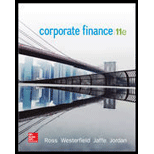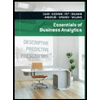
Concept explainers
Evaluating Credit Policy Air Spares is a wholesaler that stocks engine components and test equipment for the commercial aircraft industry. A new customer has placed an order for eight high-bypass turbine engines, which increase fuel economy. The variable cost is $2.6 million per unit, and the credit price is $2.815 million each. Credit is extended for one period, and based on historical experience, payment for about 1 out of every 200 such orders is never collected. The required return is 2.9 percent per period.
- a. Assuming that this is a one-time order, should it be filled'' The customer will not buy if credit is not extended.
- b. What is the break-even probability of default in part (a)?
- c. Suppose that customers who don’t default become repeat customers and place the same order every period forever. Further assume that repeat customers never default. Should the order be filled? What is the break-even probability of default?
- d. Describe in general terms why credit terms will be more liberal when repeat orders are a possibility.
a.
To explain: Whether order should be accepted or not.
Credit Policy:
Credit policies are the guidelines of a business for customers. These policies contain the terms and conditions related to credit sales.
Explanation of Solution
Given,
A company’s variable cost is $2.6 million per unit.
Credit price is $2.815 million.
Required return is 2.9%.
Bad debt is 1/200.
The order must be accepted if the net present value is positive, that means inflows are greater than outflows.
Calculate net present value (NPV).
Formula to compute net present value,
Substitute $2721987.37 for inflow and $2,600,000 for outflow.
Working note:
Calculation of inflow,
Hence, order should be accepted since the NPV is positive.
b.
To compute: Break even probability.
Explanation of Solution
Solution:
At break even probability, inflows are equal to outflows that mean net present value is zero.
Formula to calculate breakeven probability,
Substitute 0 for net present value, $2,815,000 for sales, 0.029 for return percentage and $2,600,000 for outflow.
Hence, break even probability is 4.96%.
c.
To compute: Whether order must be accepted or not and break even probability.
Explanation of Solution
Solution:
The order should be accepted if the net present value is positive that means inflows are greater than outflows.
Calculate net present value.
Formula to compute net present value,
Substitute $7,376,724.14 for inflow and $2,600,000 for outflow.
At break even probability, inflows are equal to outflows that mean net present value is zero.
Formula to calculate breakeven probability,
Substitute 0 for net present value, $215,000 for sales, 0.029 for return percentage and $2,600,000 for outflow.
Working note:
Calculation of inflow,
Hence, order should be accepted and break even probability is 64.93%.
d.
To explain: Liberty in credit terms.
Answer to Problem 9QP
Solution:
Credit terms will be more liberal when there are repeat orders.
It is believed by the company that once a customer has paid his credit, he will also repay the future credit sales.
Explanation of Solution
- It is believed that once a good customer, is always a good customer.
- It is believed that if a customer has not defaulted in past, he will not default in future as well.
Hence, credit terms will be more liberal when there are repeating of orders.
Want to see more full solutions like this?
Chapter 28 Solutions
Corporate Finance (The Mcgraw-hill/Irwin Series in Finance, Insurance, and Real Estate)
- You have an investment worth $61,345 that is expected to make regular monthly payments of $1,590 for 20 months and a special payment of $X in 3 months. The expected return for the investment is 0.92 percent per month and the first regular payment will be made in 1 month. What is X? Note: X is a positive number.arrow_forwardA bond with a par value of $1,000 and a maturity of 8 years is selling for $925. If the annual coupon rate is 7%, what’s the yield on the bond? What would be the yield if the bond had semiannual payments?arrow_forwardYou want to buy equipment that is available from 2 companies. The price of the equipment is the same for both companies. Silver Fashion would let you make quarterly payments of $14,930 for 8 years at an interest rate of 1.88 percent per quarter. Your first payment to Silver Fashion would be today. Valley Fashion would let you make X monthly payments of $73,323 at an interest rate of 0.70 percent per month. Your first payment to Valley Fashion would be in 1 month. What is X?arrow_forward
- You just bought a new car for $X. To pay for it, you took out a loan that requires regular monthly payments of $1,940 for 12 months and a special payment of $25,500 in 4 months. The interest rate on the loan is 1.06 percent per month and the first regular payment will be made in 1 month. What is X?arrow_forwardYou own 2 investments, A and B, which have a combined total value of $38,199. Investment A is expected to pay $85,300 in 6 years and has an expected return of 18.91 percent per year. Investment B is expected to pay $37,200 in X years and has an expected return of 18.10 percent. What is X?arrow_forwardYou own 2 investments, A and B, which have a combined total value of $51,280. Investment A is expected to pay $57,300 in 5 years and has an expected return of 13.13 percent per year. Investment B is expected to pay $X in 11 years and has an expected return of 12.73 percent per year. What is X?arrow_forward
- Equipment is worth $225,243. It is expected to produce regular cash flows of $51,300 per year for 9 years and a special cash flow of $27,200 in 9 years. The cost of capital is X percent per year and the first regular cash flow will be produced in 1 year. What is X?arrow_forward2 years ago, you invested $13,500. In 2 years, you expect to have $20,472. If you expect to earn the same annual return after 2 years from today as the annual return implied from the past and expected values given in the problem, then in how many years from today do you expect to have $55,607?arrow_forwardYou plan to retire in 5 years with $650,489. You plan to withdraw $88,400 per year for 20 years. The expected return is X percent per year and the first regular withdrawal is expected in 6 years. What is X?arrow_forward
 Excel Applications for Accounting PrinciplesAccountingISBN:9781111581565Author:Gaylord N. SmithPublisher:Cengage Learning
Excel Applications for Accounting PrinciplesAccountingISBN:9781111581565Author:Gaylord N. SmithPublisher:Cengage Learning Financial Accounting: The Impact on Decision Make...AccountingISBN:9781305654174Author:Gary A. Porter, Curtis L. NortonPublisher:Cengage Learning
Financial Accounting: The Impact on Decision Make...AccountingISBN:9781305654174Author:Gary A. Porter, Curtis L. NortonPublisher:Cengage Learning Cornerstones of Financial AccountingAccountingISBN:9781337690881Author:Jay Rich, Jeff JonesPublisher:Cengage Learning
Cornerstones of Financial AccountingAccountingISBN:9781337690881Author:Jay Rich, Jeff JonesPublisher:Cengage Learning Essentials Of Business AnalyticsStatisticsISBN:9781285187273Author:Camm, Jeff.Publisher:Cengage Learning,
Essentials Of Business AnalyticsStatisticsISBN:9781285187273Author:Camm, Jeff.Publisher:Cengage Learning, EBK CONTEMPORARY FINANCIAL MANAGEMENTFinanceISBN:9781337514835Author:MOYERPublisher:CENGAGE LEARNING - CONSIGNMENT
EBK CONTEMPORARY FINANCIAL MANAGEMENTFinanceISBN:9781337514835Author:MOYERPublisher:CENGAGE LEARNING - CONSIGNMENT Principles of Cost AccountingAccountingISBN:9781305087408Author:Edward J. Vanderbeck, Maria R. MitchellPublisher:Cengage Learning
Principles of Cost AccountingAccountingISBN:9781305087408Author:Edward J. Vanderbeck, Maria R. MitchellPublisher:Cengage Learning





